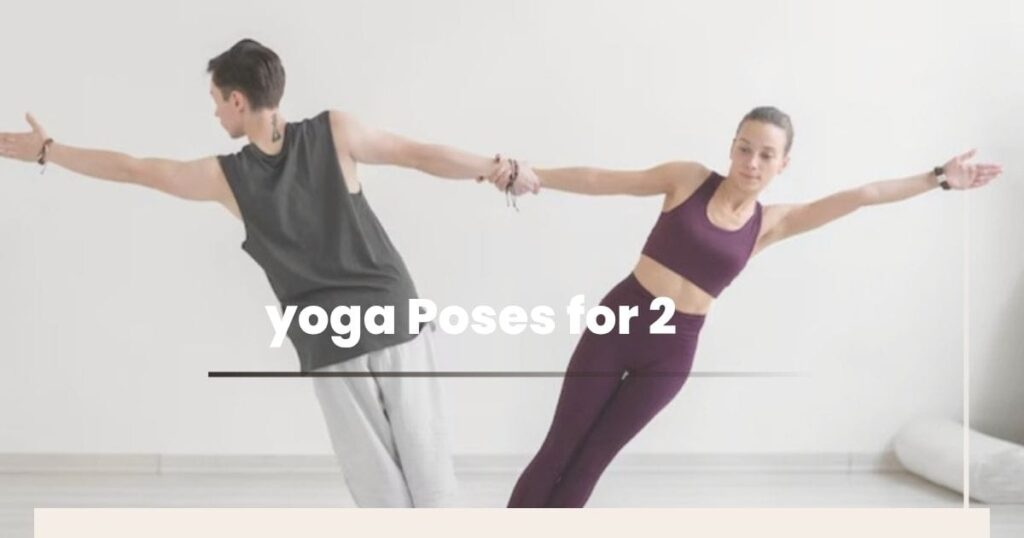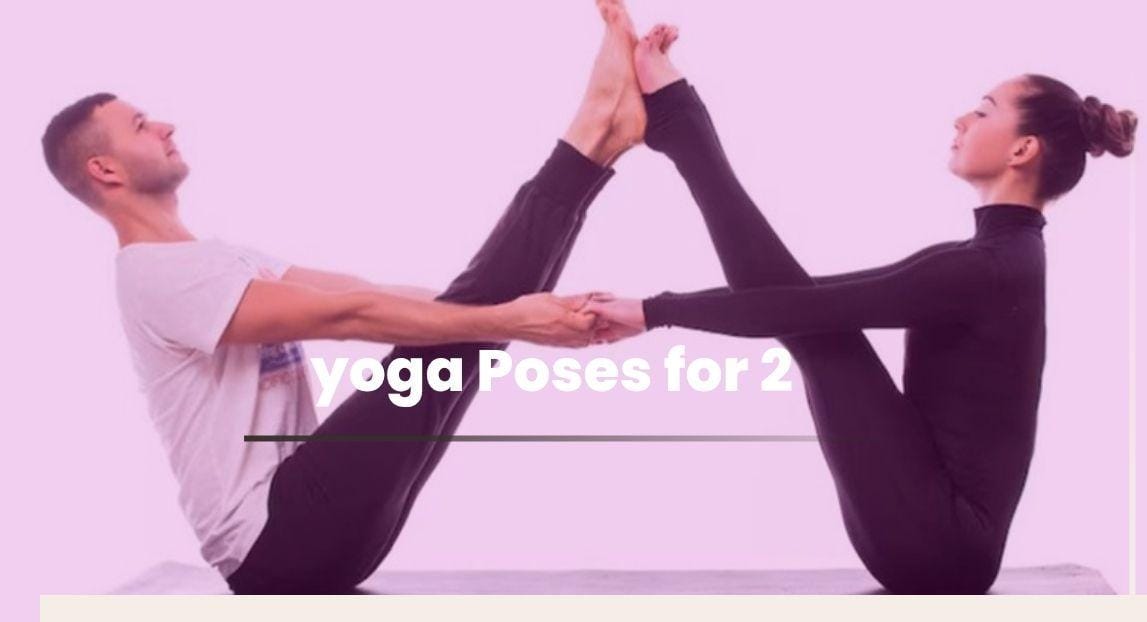Why Partner Yoga Is the New Wellness Trend
Yoga has long been considered a hugely beneficial exercise with an infinite impact on the physical, mental, and spiritual planes. But practiced with a partner, it becomes something of a spirit of connection between the participants.
Be it friend, brother, or lover, partner yoga or yoga for two is a funny way to build trust, improve communication between each other, achieve calmness, and balance in the world.
In this complete guide, we will look into easy poses of partner yoga for two beginners, how to start safely, and tips on doing it well, plus the benefits of sharing a yoga mat with someone you care about.
Benefits of Partner Yoga

Before starting with poses, let us look at the special benefits of doing yoga with a partner:
1. More Bonding and Communication
Partner yoga calls for cooperation and physical feedback with each other and thus forms an intimacy, trust, and teamwork-building agent.
2. Enhanced Flexibility and Balance
On one side, you can hold each other to deepen stretches; on the other side, partners can help with alignment, even with the simplest poses.
3. New Motivation and Accountability
Working out is more fun with someone else. Just having a partner can hold you accountable for your fitness and mindfulness.
4. Connection as a Stress Reducer
The human touch and synchronized breathing of partner yoga can reduce stress, as well as decrease cortisol levels and promote a sense of well-being.
Starting Out: Partner Yoga Tips for Beginners
Stay open-minded. Don’t worry about doing this perfectly.
Keep communicating. Talk about your breath, comfort levels, and balance.
Utilize props. Straps, cushions, and blocks are there to help support alignment.
Take your time. Begin exploring connection and breathing before attempting to do more advanced stretches.
Warm up first on your own. Get yourself a little bit warm with a few light stretches or sun salutations before starting with partner poses.
10 Easy Partner Yoga Poses for 2 Beginners Will Love
Let’s look at the best partner poses that are suitable for beginners and lots of fun.
1. Seated Breathing. (Back to Back Meditation)
How to do it:
Sit back-to-back with your partner, have your legs crossed in front of you.
Close your eyes; align your spines.
Together, inhale deeply and exhale together in a synchronized pattern.
Benefits: Creates a connection, calming and focuses the mind in a partnered mindfulness experience.
2. Partner Forward Fold
How to do it:
Sit facing each other, legs extended, and feet touching.
Grab each other’s hands (or forearms).
One partner slowly leans back, aiding the other in their forward fold
Hold for 5 breaths and switch.
Benefits: Stretches hamstrings and lower back
3. Double Downward Dog:
How to do:
One partner begins in downward dog, while the other partner stands carefully behind and places their hands on the mat and feet on the lower back (or hips) of their partner, also in downward dog shape!
Benefits: Builds strength in the arms and legs, builds balance, and provides a nice stretch.
4. Partner Chair Pose (back-to-back):
How to do:
Stand back-to-back with your partner with your feet hip-width apart, and slowly walk your feet out in front of you as you bend your knees into a sitting position until you are both sitting back-to-back and supporting each other!
Wait for 5–10 breaths
The benefits of performing this pose: Leg strength and core stability, improves coordination.
5. Twin Tree Pose
How to do it:
Stand side by side and bring your inside arms around each other’s waist.
Bring your outside foot to the inside of your leg (as you would in tree pose).
Use each other for balance.
Benefits: Improves focus, balance, and relationships within the physical space.
6. Partner Cat-Cow
How do you do it?
Get on `all fours` facing each other.
Hands on each other’s shoulders.
While one person inhales into cow pose (chest up, tailbone up), the other exhales into cat pose (rounded spine).
Continue to alternate your breath and movement.
Benefits: Improved spinal mobility and coordinated breathing style.
7. Double Boat Pose
How to do it?
Sit with each other, knees ben,t toes touching.
Hold hands and press the soles of your feet together.
Slowly lift feet, moving together into an extended position (legs and feet create a hard angle).
Balance for 3–5 breaths.
Benefits: Core stability, improved posture, and playfulness.
8. Partner twist
How to do it:
Sit cross-legged with our backs touching.
Inhale, the twist to the right (left hand on your partner’s right knee and right hand am on your partner’s left knee).
Hold, then switch sides.
Benefits:More spinal mobility and aids digestion.
9. Supported backbend
How to do it:
One person kneels and leans back.
The other stands and supports their partner’s back with their hands on the back, shoulders, and arms.
The partner can also gently hold their arms to deepen the stretch.
Benefits: Opens the chest and shoulders and provides trust.
10. Partner Savasana and connection of hands
How to do it:
Lay side by side with a couple of inches of space between you.
Hold hands or lay your arms next to each other.
Close your eyes, focus on your breath, and allow yourself to completely relax.
Benefits: Promotes emotional release, connection, and total relaxation.
Developing a Sustainable Partner Yoga Practice
If you and your partner have found a practice that you enjoy, there are examples to help keep partner yoga a habitual practice:
Make a schedule
Start small and commit to the practice for 20-30 minutes, 2-3 days a week.
Take a few minutes for breath practices or meditation
Consider developing a breathing practice or a guided meditation that you both can experience for a few minutes before or after your partner yoga practice.
Change it up
Variety is useful; strength poses, flexibility sequences, and simple child-like balancing poses are only a few ways to keep your partner yoga practice fresh and exciting.
Pay attention to your progress
Make note of your flexible improvements, your postures, your balance, and perhaps your emotional connectivity.
Bonus: Set up a mini Yoga Date Night
To connect with your partner on a deeper level, plan a Yoga Date Night. Here are several possibilities:
Set up the atmosphere: Use a calm light ambience, candlelight, or relaxed music, so you create a peaceful and inviting space for each other.
Warm-up together: Start with a few independent stretches before entering partner poses to warm your body up first.
Combine theming with a flow: You can do a flow that has some intent, like heart openers, grounding, or laughter yoga.
Finish with a Massage, or herbal tea: End the in-depth yoga time with a back massage or tea to share.
Common Mistakes in Partner Yoga
Overstretching your partner
Allow for stretching in partner work—they should never be forced into a deeper stretch and should just allow their body to deeply open.
Ignoring communication
While you are practicing together, you should talk after every pose. Inquire how your partner is feeling.
Comparing flexibility
As partner practitioners, you do not need to be “as good” as your partner. The practice enables support and growth between you both.
Skipping warm-ups
If you are a beginner, warm-ups are important because you can still hurt cold muscles in beginner poses.
Conclusion: Stretching Together Creates More than Just Flexibility
Partner yoga encourages you to move together as a couple, which is often missing from regular daily movement. Partner yoga poses are more than just yoga postures—they are opportunities for you to build trust, laughter, and communication between you both and create a path for deepening your relationship through mindful movement! Whether you are strengthening a romantic relationship or reconnecting with a friend, or even trying something new, partner yoga is a beginner-friendly option for all.
So, grab someone you trust, roll out your mats, and see how stretching together helps you stay together, physically, emotionally, and spiritually.
FAQs
1. Do I need to be flexible in order to do partner yoga?
No! Most poses can easily be adapted, and your partner can engage with you to help support and encourage your movement.
2. Can I do this with my child or parent?
Yes! Partner yoga is safe and fun for all ages as long as you adapt the poses to everyone’s fitness levels.
3. Is partner yoga romantic?
It can be! While many people do partner yoga in a platonic way, couples find that partner yoga creates increased intimacy and emotional connection.
4. What should I wear to partner yoga?
Comfortable, breathable, stretchy clothing similar to what you would wear to solo yoga. Avoid slippery materials.








